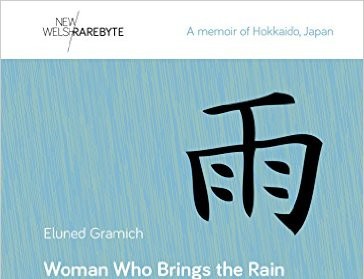Steven Hendon reviews Women Who Brings the Rain by Eluned Gramich, a memoir that reflects themes of cultural multiplicity during her stay in Japan.
Eluned Gramich’s memoir of her stay on the island of Hokkaido, Japan – via a Daiwa Anglo-Japanese Foundation scholarship – comes as a Kindle e-Book, and the e-reader helpfully lets purchasers know that it takes about an hour to read. Brief, then; brief yet meaningful, since she writes memorably about what it means to be open-minded regarding other cultures. Topical in a global context, to say the least, and it’s an hour well spent.
Gramich begins life in Nisekō, Hokkaido by having to translate, or mistranslate, everything into English. Her host family has written a note of welcome: ‘[we] are so looking forward to meeting you, we could cut our throats’, or so she first thinks, amusingly, and her account is refreshingly honest about the difficulties and embarrassments that confront her. As one might expect, developing an understanding of language is critical, but what quickly becomes apparent is that this goes hand-in-hand with an enlightening appreciation of the natural environment and its relationship to people. Central to that process in this particular place is ‘Yōtei-San … Hokkaido’s Mount Fuji.’ ‘San’, as Gramich explains, is similar to the English appellation ‘Mr’ or ‘Mrs’, so when she describes the mountain ‘greeting and observing’ her in the morning and at night we see her gradually being drawn into the indigenous manner of thought.
Yōtei-San is a stern male figure: he doesn’t like visitors, or to be painted, or praised in poetry, and in these images of an elevated and controlling human-like presence we first see a skilfully crafted narrative that guides us towards the idea of Hokkaido as peripheral and different in relation to the Japanese mainland in the same way that Wales is characteristically distinct from England. Interestingly, Gramich points out that Hokkaido experienced a central government policy of colonisation and inward migration in the mid-nineteenth century, as may be said of Wales during the same period.
Key to the success of this memoir is the way in which Gramich conveys poetically and sensitively the complexities of language and culture. The palimpsest nature of place names, for instance, also evokes thoughts of Wales: ‘Multiple names testify to the history of the people who lived there. Like the layers of an archaeological site, each name can be dug up to reveal an older name underneath. And, like fragments of porcelain in the soil, a name, uncovered and examined, can be a clue to the region’s history, its past cultures.’
Woman Who Brings the Rain, though, is considerably more than home thoughts from abroad. Gramich is both observer and participant: the title smilingly refers to the name given to her by the locals since she seems to bring with her Welsh rain wherever she goes, but more seriously she is primarily interested in integrating with her hosts. Although she describes the decorative writing that she produces during Japanese calligraphy lessons that she attends as ‘awful’, the subject matter that engages her – autumn – enables a fuller recognition of the inter-connectedness of people, nature and environment first suggested through the imagery of Yōtei-San. There is a lesson for us all in her analysis of seasonal and cyclical change and in the emotion of ‘time’s fleetingness, the ebb and tide, loss and gain, of the year.’ For people too have the ‘power to change’, and it is a final involvement in Hokkaido’s natural world that brings about Gramich’s own transformation, making her more open to ‘new thoughts and experiences’ that clarify her position.
This personal memoir speaks in a modern political way about ideas of two-way processes of cultural inclusion. As Gramich immerses herself in the possibilities of her new environment – ‘I went outside and saw the magic for myself and accepted it’ – so her hosts come to accept and value her. They convey this by way of a tiny gift, a hanko – a seal, normally used for ceremonial purposes, with her Welsh name carved on it in Japanese. Like many small things, including the memoir itself, the seal has significant and lasting value, denoting the formation of another ‘self’, as Gramich puts it – one that no longer needs to translate.
There are many qualities to admire in Woman Who Brings the Rain: Gramich’s adroit and touching narrative, her poetic style, and lightness of touch are but a few examples. Most rewarding is the philosophical approach revealed at the memoir’s core: her embracing of notions of cultural multiplicity, fluidity and adaptability that suits perfectly the changing boundaries of our modern world.











